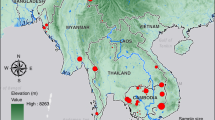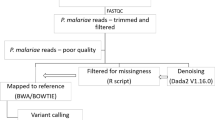Abstract
The Malaria's Eve hypothesis, proposing a severe recent population bottleneck (about 3,000–5,000 years ago) of the human malaria parasite Plasmodium falciparum, has prompted a debate about the origin and evolution of the parasite1,2,3,4,5,6. The hypothesis implies that the parasite population is relatively homogeneous, favouring malaria control measures. Other studies, however, suggested an ancient origin and large effective population size5,7,8,9,10. To test the hypothesis, we analysed single nucleotide polymorphisms (SNPs) from 204 genes on chromosome 3 of P. falciparum. We have identified 403 polymorphic sites, including 238 SNPs and 165 microsatellites, from five parasite clones, establishing chromosome-wide haplotypes and a dense map with one polymorphic marker per ∼2.3 kilobases. On the basis of synonymous SNPs and non-coding SNPs, we estimate the time to the most recent common ancestor to be ∼100,000–180,000 years, significantly older than the proposed bottleneck. Our estimated divergence time coincides approximately with the start of human population expansion11, and is consistent with a genetically complex organism able to evade host immunity and other antimalarial efforts.
This is a preview of subscription content, access via your institution
Access options
Subscribe to this journal
Receive 51 print issues and online access
$199.00 per year
only $3.90 per issue
Buy this article
- Purchase on Springer Link
- Instant access to full article PDF
Prices may be subject to local taxes which are calculated during checkout


Similar content being viewed by others
References
Rich, S. M., Licht, M. C., Hudson, R. R. & Ayala, F. J. Malaria's Eve: evidence of a recent population bottleneck throughout the world populations of Plasmodium falciparum. Proc. Natl Acad. Sci. USA 95, 4425–4430 (1998)
Volkman, S. K. et al. Recent origin of Plasmodium falciparum from a single progenitor. Science 293, 482–484 (2001)
Hughes, A. L. & Verra, F. Ancient polymorphism and the hypothesis of a recent bottleneck in the malaria parasite Plasmodium falciparum. Genetics 150, 511–513 (1998)
Hey, J. Parasite populations: the puzzle of Plasmodium. Curr. Biol. 9, R565–R567 (1999)
Hughes, A. L. & Verra, F. Very large long-term effective population size in the virulent human malaria parasite Plasmodium falciparum. Proc. R. Soc. Lond. B 268, 1855–1860 (2001)
Saul, A. Circumsporozoite polymorphisms, silent mutations and the evolution of Plasmodium falciparum. Parasitol. Today 15, 38–40 (1999)
Escalante, A. A., Barrio, E. & Ayala, F. J. Evolutionary origin of human and primate malarias: evidence from the circumsporozoite protein gene. Mol. Biol. Evol. 12, 616–626 (1995)
Walliker, D., Babiker, H. & Ranford-Cartwright, L. in Malaria: Parasite Biology, Pathogenesis, and Protection (ed. Sherman, I. W.) 235–252 (American Society for Microbiology, Washington DC, 1998)
Conway, D. J. et al. High recombination rate in natural populations of Plasmodium falciparum. Proc. Natl Acad. Sci. USA 96, 4506–4511 (1999)
Anderson, T. J. et al. Microsatellite markers reveal a spectrum of population structures in the malaria parasite Plasmodium falciparum. Mol. Biol. Evol. 17, 1467–1482 (2000)
Templeton, A. Out of Africa again and again. Nature 416, 45–51 (2002)
Gardner, M. J. et al. Chromosome 2 sequence of the human malaria parasite Plasmodium falciparum. Science 282, 1126–1132 (1998)
Bowman, S. et al. The complete nucleotide sequence of chromosome 3 of Plasmodium falciparum. Nature 400, 532–538 (1999)
Cargill, M. et al. Characterization of single-nucleotide polymorphisms in coding regions of human genes. Nature Genet. 22, 231–238 (1999)
Graur, D. & Li, W.-h. Fundamentals of Molecular Evolution (Sinauer, Sunderland, Massachusetts, 2000)
Su, X. et al. A genetic map and recombination parameters of the human malaria parasite Plasmodium falciparum. Science 286, 1351–1353 (1999)
Yang, Z. PAML: a program package for phylogenetic analysis by maximum likelihood. Comput. Appl. Biosci. 13, 555–556 (1997)
Hughes, A. L. Circumsporozoite protein genes of malaria parasites (Plasmodium spp.): evidence for positive selection on immunogenic regions. Genetics 127, 345–353 (1991)
Musto, H., Romero, H., Zavala, A., Jabbari, K. & Bernardi, G. Synonymous codon choices in the extremely GC-poor genome of Plasmodium falciparum: compositional constraints and translational selection. J. Mol. Evol. 49, 27–35 (1999)
Pizzi, E. & Frontali, C. Low-complexity regions in Plasmodium falciparum proteins. Genome Res. 11, 218–229 (2001)
Wootton, J. C. Non-globular domains in protein sequences: automated segmentation using complexity measures. Comput. Chem. 18, 269–285 (1994)
Wootton, J. C. et al. Genetic diversity and chloroquine selective sweeps in Plasmodium falciparum. Nature, 418, 320–323
Louis, A., Ollivier, E., Aude, J. C. & Risler, J. L. Massive sequence comparisons as a help in annotating genomic sequences. Genome Res. 11, 1296–1303 (2001)
Su, X., Kirkman, L. A., Fujioka, H. & Wellems, T. E. Complex polymorphisms in an approximately 330 kDa protein are linked to chloroquine-resistant P. falciparum in Southeast Asia and Africa. Cell 91, 593–603 (1997)
Rozas, J. & Rozas, R. DnaSP version 3: an integrated program for molecular population genetics and molecular evolution analysis. Bioinformatics 15, 174–175 (1999)
Wootton, J. C. & Federhen, S. Statistics of local complexity in amino acid sequence databases. Comput. Chem. 17, 149–163 (1993)
Yu, A. et al. Comparison of human genetic and sequence-based physical maps. Nature 409, 951–953 (2001)
Swofford, D. L. PAUP*. Phylogenetic Analysis Using Parsimony (*and other methods). Version 4 (Sinauer Associates, Sunderland, Massachusetts, 2000).
Posada, D. & Crandall, K. A. MODELTEST: testing the model of DNA substitution. Bioinformatics 14, 817–818 (1998)
Acknowledgements
We thank T. Anderson, A. Saul, K. Hayton and J. Ribeiro for critical reading of the manuscript, and B. Marshall for editorial assistance. We also thank J. Wootton for supporting O.H.B. This work was partially supported by the NIH (W.-H.L.).
Author information
Authors and Affiliations
Corresponding author
Ethics declarations
Competing interests
The authors declare that they have no competing financial interests.
Rights and permissions
About this article
Cite this article
Mu, J., Duan, J., Makova, K. et al. Chromosome-wide SNPs reveal an ancient origin for Plasmodium falciparum. Nature 418, 323–324 (2002). https://doi.org/10.1038/nature00836
Received:
Accepted:
Issue Date:
DOI: https://doi.org/10.1038/nature00836
This article is cited by
-
The Possible Time and Region of Host Switches of Ancient Malaria Parasites with Reference to the Pliocene–Quaternary Archaeological Sites in Africa
African Archaeological Review (2022)
-
Human unconventional T cells in Plasmodium falciparum infection
Seminars in Immunopathology (2020)
-
Polymorphisms of the artemisinin resistant marker (K13) in Plasmodium falciparum parasite populations of Grande Comore Island 10 years after artemisinin combination therapy
Parasites & Vectors (2015)
-
High prevalence of pfcrt-CVIET haplotype in isolates from asymptomatic and symptomatic patients in south-central Oromia, Ethiopia
Malaria Journal (2014)
-
Species-specific markers for the differential diagnosis of Trypanosoma cruzi and Trypanosoma rangeli and polymorphisms detection in Trypanosoma rangeli
Parasitology Research (2014)
Comments
By submitting a comment you agree to abide by our Terms and Community Guidelines. If you find something abusive or that does not comply with our terms or guidelines please flag it as inappropriate.



